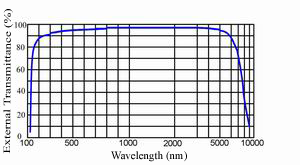|
|
Magnesium Fluoride (MgF2) |
||||||||||||||||||||||||||||||||||||||||||||||||||||||||||||||||||||||||||||||||||||||||||||||||||
|
Magnesium Fluoride crystal has a wide transmission range from 110nm to 7500nm and it exhibits a slight birefringence. The crystal is relatively hard, resistance to water, but sensitive to thermal shock. It can be machined with standard diamond tools and have a good polishing using either aluminum oxide or diamond based polishing papers. It is particularly useful for excimer laser application. Generally, Magnesium Fluoride for laser use is recommended to be oriented along the optic axis to avoid birefringent effects.
|
||||||||||||||||||||||||||||||||||||||||||||||||||||||||||||||||||||||||||||||||||||||||||||||||||||
Copyright © 2016 Precision Micro-Optics Inc. All Rights Reserved.



